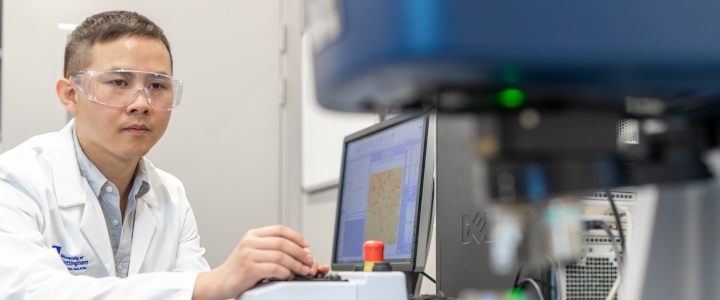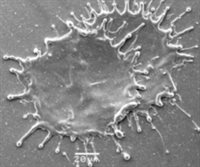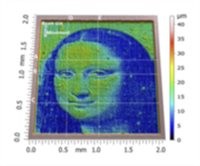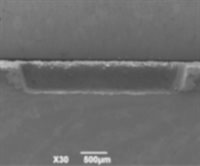
Advanced Manufacturing Processes
The University Technology Centre (UTC) in Manufacturing has a good capability on advanced manufacturing technologies such as conventional machining, waterjet milling/cutting, pulsed laser ablation, ultrasonic polishing, as well as in-depth materials properties characterisation (SEM, XRD, EBSD, TEM, Raman Spectroscopy, Micromechanics test) after machining.
The surface integrity and machining processes of relevant materials such as Superalloys, Composites, Biomaterials, Thermal Barrier Coatings, etc. are part of our research field. Innovative monitoring of manufacturing processes using a wide range of sensing solutions (force cells, accelerometers, acoustic emission, laser, strain gauges, PVDF, high speed imaging systems, etc.) have also been developed.
Our group has extensive experience in investigating workpiece surface integrity after material removal operations and understanding the phenomenological aspects related to surface deterioration. This places our research group at the forefront of research in manufacturing technology with unique opportunities to develop next-generation manufacturing processes.
Contacts
Academics
Researchers
Postgraduates
Research and Developement List
Here you can find information about our projects.
Thermally assisted machining of difficult-to-cut materials (THERMACH)
Being composed of a soft/ductile phase (i.e. the matrix) and a hard/brittle phase (i.e. the reinforcement), machining of metal matrix composites MMCs can be quite difficult to machine. Thus, THERMACH aims to tackle this by exploring and understanding how thermally assisted machining can improve the cutting performance of this type of materials.
This involves Laser Assisted Machining (LAM), i.e. laser-heating the workpiece prior to machining, with a specific scanning speed and path to optimise the mechanical properties at a given depth of cut and with a specific set of machining parameters.
Employing materials characterisation, surface integrity analysis, tool wear and production capability analysis, this project aims to be a step forward on the machinability of the MMCs that are used in aeronautic, biomedical and capital goods industries.
Tell me more
- Micromechanical testing unit for materials characterisation at the micro and nanoscales.
- Alemnis Standard Assembly (ASA) and High Strain Rate (HSR) module.
- Test types: nanoindentation, nanoscratch, micropillar compression, cantilever beam bending.
- Suitable for evaluation of failure mode, fracture toughness, elastic and plastic properties, fatigue behaviour, high-strain rate properties.
Surface Integrity refers to the alteration of machined surfaces compared to those of the bulk material, in terms of metallurgical, mechanical and chemical properties.
Exceeding particular surface anomalies limits can lead to a decline in service performance, this can be from failure modes such as fatigue.
Surface inspections are performed to ensure the absence of defects (such as cracking, high lapping or plucking) on machined surfaces and to provide “damage free” surfaces for improved fatigue performance, which is of the highest priority for aerospace components.
Machining of complex and/or light-weight aerospace components made of Ni/Ti Superalloys require the use of innovative machining techniques to address key challenges such as surface integrity, dynamic behaviour, and accelerated tool wear.
In addition to developing innovative and patented tooling technologies for machining complex profiles in aerospace alloys, we have expertise in process parameter selection based on surface integrity analysis, part and machine tool dynamics.
Extensive experience also exists in evaluation of machining cutting fluids.
The UTC research team has extensive experience in performing experimental and analytical/finite element modelling of Abrasive Waterjet Machining (e.g. through cutting, milling, cleaning) of a wide range of materials for the manufacture of high value-added components for aerospace, medical and tooling industries.
Bone cutting is an important procedure in most surgery operations, surface/tool damages, high cutting temperature/force need to be avoided. Studying and modelling bone cutting chip formation mechanism is important to design tools and optimise the surgery process.
The UTC has investigated and modelled the chip formation mechanism in bone cutting process while a wavelet-based process monitoring process was proposed with AE sensory measure for monitoring bone cutting process and support the understanding of the cutting phenomena on this unique material. We also proposed a novel design of a milling cutter, which includes on the back of main cutting edge a succession of micro-cutting edges arranged on an Archimedes spiral that allows the limitation of surface damage. The tool benefits with high cutting efficiency, smooth surface, low cutting force and temperature.

Overlapped Craters on Supperalloy

PLA process modelling

Micromachining of TBC via PLA
Pulsed Laser Ablation for micromachining applications has gained an enormous following in recent years due to their ability to machine virtually any material, producing features with resolution on the orders of micrometres while simultaneously causing small thermal and surface damage to the workpiece.
Various projects related to the use of PLA for micromachining of hard-to-cut materials (i.e. Superalloys, ceramics), as well as modelling to achieve in-process control of the removal process, are currently being investigated at the UTC.
Coating Technology represents a key area in the aerospace industry, demanding constant improvements to keep pace with recent trends in modern aeroengine design. In order to achieve a higher control on coating specific properties to match any particular application, it is essential to gain a fundamental understanding on behaviour of the material and its response to external stimuli.
Frames from the high speed imaging system showing the cutting mechanism for different fibre orientation.
Ceramic Matrix Composites (CMCs) have been an important research field within the aerospace industry in these last years. The anisotropic, heterogeneous, brittle and hard nature of these materials challenges the machining process in terms of surface characterisation and tool design.
Different projects where the fundamentals of cutting and surface characterisation are studied followed with the development of novel cutting tools.
Micro-pattern Polycrystalline Diamond (PCD) tools for grinding and dressing applications.
The limitations of conventional machining methods with undefined cutting edges on the prediction of the impressions left on the work surface are directly associated to the inherent stochastic nature of the abrasive particles with regard to their size and protrusion, shape, location and spacing.
An innovative approach of engineered (super)abrasive tools based on the generation of controlled-shape micro-feature arrangements on PCD and CVD diamond structures with pulse laser ablation has been taken to overcome the randomness associated with the material removal process. This concept opens the door to the customisation of precision tooling for specific applications (drilling, dressing, grinding, etc.) and difficult-to-machine workpiece materials.
Coating Technology represents a key area in the aerospace industry, demanding constant improvements to keep pace with recent trends in modern aeroengine design. In order to achieve a higher control on coating specific properties to match any particular application, it is essential to gain a fundamental understanding on behaviour of the material and its response to external stimuli.
The UTC has been involved in a number of projects to perform advanced characterization of Thermal Barrier Coatings (routinely used in aeroengines), as well as currently developing new technology to allow in-situ repair of delaminated coatings from within the engine.
Orientation affects application-defining properties of crystalline materials, therefore information in this regard is highly-prized. Conventional microstructural analysis methods, such as electron backscatter diffraction, are currently incompatible with high-throughput manufacturing due to large time and cost penalties involved.
This project applies electrochemical jet processing (EJP), coupled with accurate topographic acquisition, to rapidly characterise crystallographic texture in different engineering materials. Implementation of EJP can allow localised dissolution to be anisotropic and dependent on etch-rate selectivity, defined by the crystallography. EJP therefore can generate complex, but characteristic topographies. Through rapid surface processing and analysis, textural information can be elucidated and resolved over limited timescales and intervention.
Surface Integrity Conscious High-Performance Hybrid Machining for Safety-Critical Superalloy Aeroengine Parts (STIMULANT)
STIMULANT aims to develop and demonstrate “surface integrity conscious” hybridisation of machining processes for safety-critical aero engine parts that is able to deliver a step-change in Material Removal Rates (MRR) and reduction in production costs. STIMULANT will take key knowledge at different levels of maturity that exists within Consortium, and progress it, via Standard Features (StdFs) methodology, to the demonstration on “engine-like” safety critical parts.
Tell me more
Sensor Enabled Systems for Precision Cutting (SENSYCUT)
Machining is one of the most used processes for producing precision parts used in aerospace and automotive industries. The demand for high performance and quality assured parts requires high precision, often over a large scale resulting in increased manufacturing costs. It has become a rule of thumb that precise machines with stiff structures and large foot prints are required for machining precision parts. As a consequence, machining costs grow exponentially as the precision increases. This has resulted in the development of expensive and non-value adding off-line verification and error compensation methods. However, these methods do not take the impact of cutting tool/workpiece geometry, cutting forces and time variable errors into account. The uptake of additive manufacturing has also resulted in generation of optimised parts often with complex geometries and thin and high walls which require finish machining with long slender tools. In these scenarios, cutting forces can bend the tool and the workpiece resulting in geometrical inaccuracies. Fluctuating cutting forces result in chatter leading to damaged surface integrity and short tool life.
Using new sensors, advanced signal processing and intelligent control systems can provide the ability to detect geometrical and surface anomalies when machining, and provide data to generate strategies to prevent costly mistakes and poor quality. However, off-the-shelf sensors and data transmission devices are not necessarily suitable for monitoring and controlling machining processes. Existing high precision sensors are either too large or too expensive making them only useful for laboratory applications. Conventional statistical and process control methods cannot cope with high data sampling rates required in machining.
The proposed research will realise low-cost sensors with nano scale resolution specific to machining, tools and intelligent control methods for precision machining of large parts by detecting and preventing anomalies during machining to ensure high precision part manufacture and prevent scrap production.
Tell me more